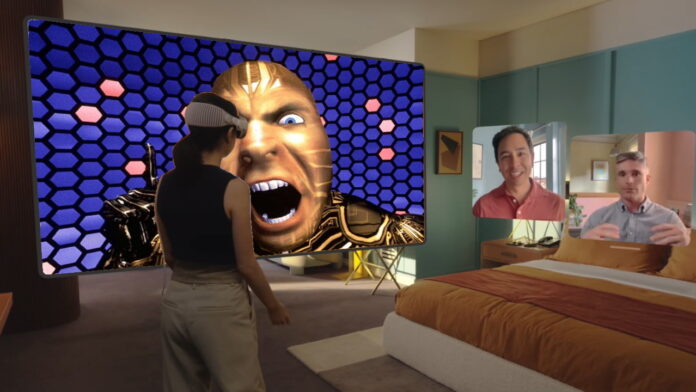Apple finally announced the Vision Pro headset, a $3,499 spatial computing device set to arrive early next year. That’s no small chunk of change, so it’s important to know exactly what you’re getting for your money. Of course, we plan to test and review the Vision Pro as soon as we can get our hands on one, but until then we have one big question: Is it an augmented reality (AR) headset or a virtual reality (VR) headset? Apple isn’t saying, so we’re here to break down everything we know to get to the bottom of it.
It’s a VR Headset…
Strictly using the definitions of AR and VR that we’ve relied on in the past, the Apple Vision Pro is unquestionably a VR headset. It’s an opaque (to the wearer) heads-up display that completely covers and takes over the user’s vision. That’s traditionally where we draw the line between VR and AR.
Promotional material shows the Apple Vision Pro used with projected apps around physical spaces, and the EyeSight feature makes the display transparent to people around the user when they’re nearby. However, it doesn’t actually become transparent for the user, so the view is still determined entirely by the OLED screens.
(Credit: Apple)
As far as the design is concerned, the Apple Vision Pro is similar to the Meta Quest Pro: It has color cameras and onboard spatial processing that can project apps and experiences onto a representation of the real world. Even so, we have to call it a VR headset because it doesn’t actually overlay that information in a transparent way like the HoloLens, Magic Leap, or Google Glass. It’s not in any way an AR headset because its hardware DNA is based on VR technology.
…That Acts Like an AR Headset
The Vision Pro’s spatial computing features are the core of the headset’s AR functionality. Its interface design is built using what’s around you. It takes your physical surroundings, recreates them visually in the headset, and then places its own user interface, apps, and content on top of that representation. It can project screens throughout your field of view, letting you virtually use multiple monitors with your physical keyboard and mouse at the same time. It can take 3D renders and place them virtually on your real-world desk.
But it can also completely take over your view and put you in a fully virtual environment (app, game, movie)—and that’s VR. And yet most of what Apple showed in the launch video demonstrated the AR aspects of the Vision Pro.
(Credit: Apple)
Conceptually, the Vision Pro is an AR headset, but how effective that AR experience is depends on how good the outward-facing cameras are. The Meta Quest Pro has similar AR features, and the colorized view does significantly improve the experience, but it’s still not sharp enough to truly represent your actual physical surroundings.
Based on what we’ve seen so far, the Vision Pro’s 12 cameras appear to be quite capable. Of course, we’ll reserve final judgment until we are able to test the headset ourselves.
Recommended by Our Editors
Mixed Reality Is More Like It
Mixed reality (MR) is a vague term that Microsoft tried to popularize with its Windows-powered, third-party-manufactured headsets, but those headsets were still entirely VR in execution. However, mixed reality (or extended reality, also known as XR) has become a catch-all that describes any technology that sits between AR and VR.
We might be able to more clearly label exactly what the Vision Pro is as Apple provides more information about its features, so make sure to check back as we update this story. For now, we’re calling the Vision Pro a VR headset that includes an extensive array of AR features—which basically makes it an XR headset.
For more, check out 5 affordable alternatives to the Apple Vision Pro.
















